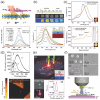Plasmonics of 2D Nanomaterials: Properties and Applications
- PMID: 28852608
- PMCID: PMC5566264
- DOI: 10.1002/advs.201600430
Plasmonics of 2D Nanomaterials: Properties and Applications
Abstract
Plasmonics has developed for decades in the field of condensed matter physics and optics. Based on the classical Maxwell theory, collective excitations exhibit profound light-matter interaction properties beyond classical physics in lots of material systems. With the development of nanofabrication and characterization technology, ultra-thin two-dimensional (2D) nanomaterials attract tremendous interest and show exceptional plasmonic properties. Here, we elaborate the advanced optical properties of 2D materials especially graphene and monolayer molybdenum disulfide (MoS2), review the plasmonic properties of graphene, and discuss the coupling effect in hybrid 2D nanomaterials. Then, the plasmonic tuning methods of 2D nanomaterials are presented from theoretical models to experimental investigations. Furthermore, we reveal the potential applications in photocatalysis, photovoltaics and photodetections, based on the development of 2D nanomaterials, we make a prospect for the future theoretical physics and practical applications.
Keywords: 2D materials; light‐matter interactions; optoelectronics; surface plasmons.
Figures









References
-
- Mak K. F., Lee C., Hone J., Shan J., Heinz T. F., Phys. Rev. Lett. 2010, 105, 136805. - PubMed
-
- Dai S., Fei Z., Ma Q., Rodin A. S., Wagner M., McLeod A. S., Liu M. K., Gannett W., Regan W., Watanabe K., Science 2014, 343, 1125. - PubMed
-
- Lin Y., Williams T. V., Connell J. W., J. Phys. Chem. Lett. 2009, 1, 277.
-
- Radisavljevic B., Radenovic A., Brivio J., Giacometti V., Kis A., Nat. Nanotechnol. 2011, 6, 147. - PubMed
-
- Geim A. K., Novoselov K. S., Nat. Mater. 2007, 6, 183. - PubMed
Publication types
LinkOut - more resources
Full Text Sources
Other Literature Sources
